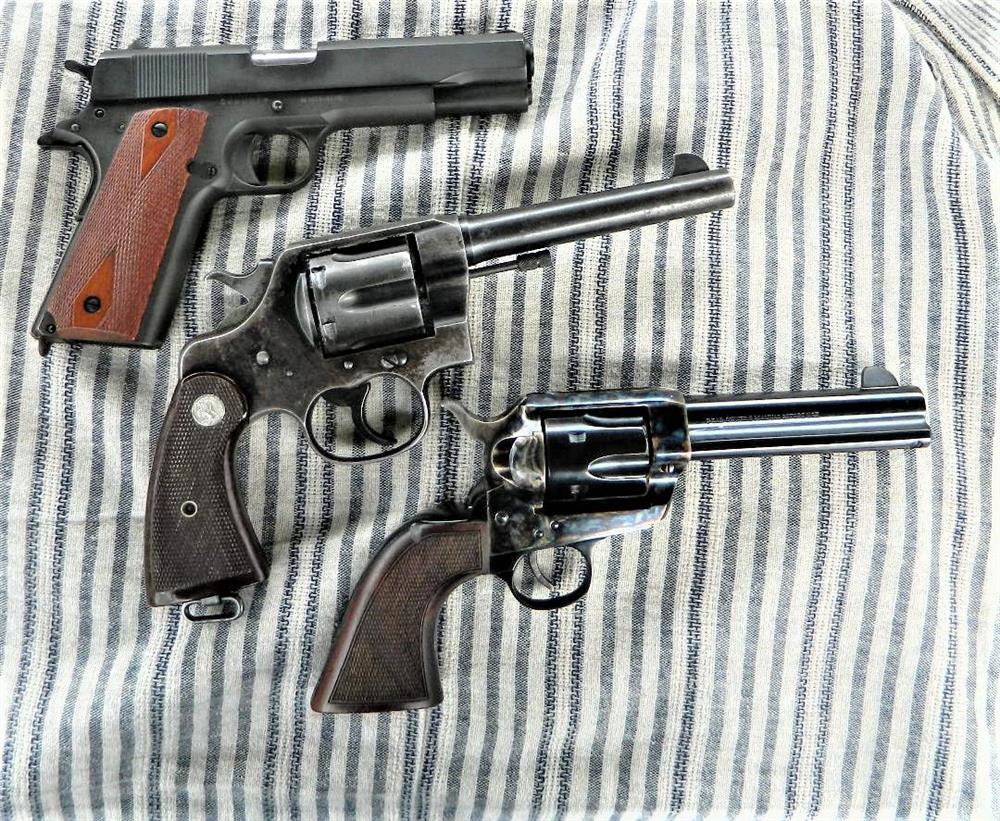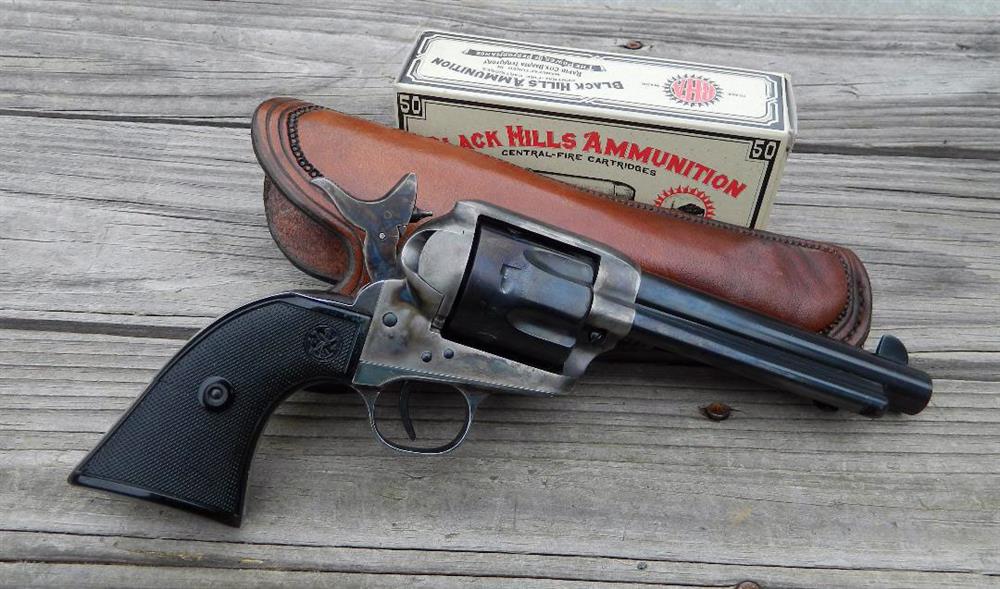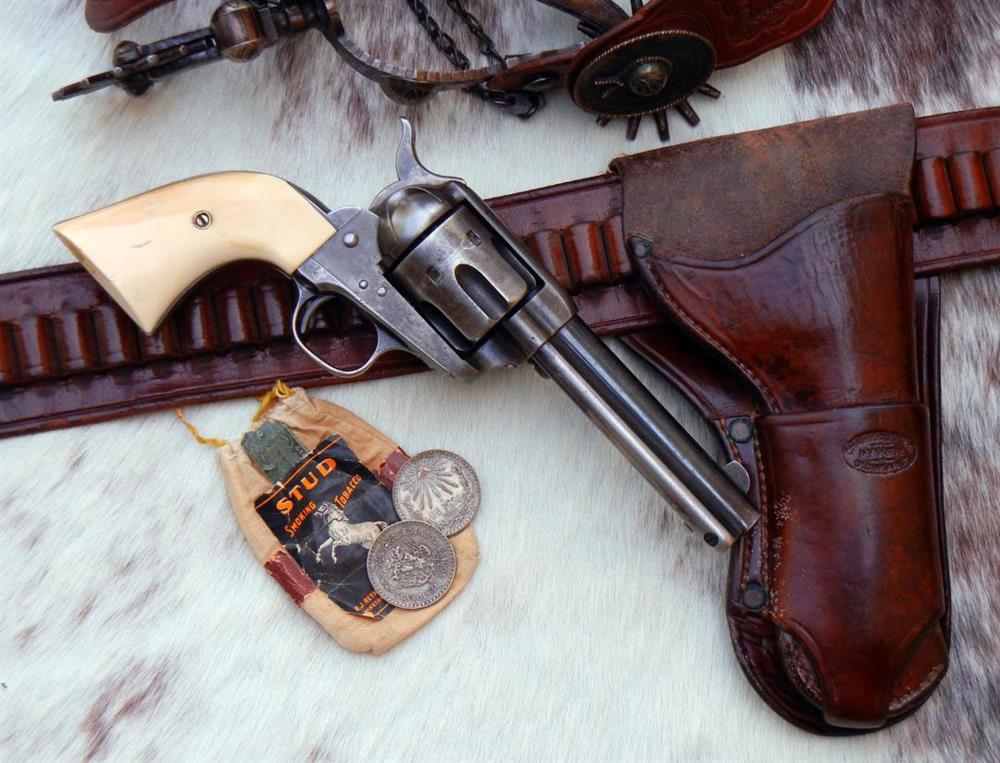Gents, Please send me one of your Nickel plated .45 Caliber revolvers. It is for my own use, and for that reason, I would like to have a little Extra pains taken with it. I am willing to pay the Extra for Extra work. Make it very easy on the trigger, and have the front Sight a little higher and thicker than the ordinary pistol of this Kind. Put on a gutta percha handle, and send it as soon as possible. Have the barrel about the same length that the ejecting rod is.
Truly yours,
W.B. Masterson

A gun has a face, a soul, and a history. Some handguns have been around the block. However, it was the Colt Single Action Army revolver that built the block. The relationship to firearms isn’t attachment to an inanimate object, but rather to the country, and a respect for the men who used the firearm.
Handguns are used in great wars and battles, but most of the actions are close range and of a more personal nature. These battles are less important to the world but important to the men involved in them. The men who used the gun, the men who invented the gun, and the craftsmen that made the gun, are all important. I mean, this in the best sense of the word, the Colt is made by Yankee craftsmen in Hartford Connecticut and has been for many years—over 140 years for the Colt Single Action Army. This handgun was selected for the U.S. Army partly due to General Stephen Benet’s insistence that the Army have the best tool for the job.
Among the chores the Colt Single Action Army had to perform was dropping an Indian war pony at 100 yards. The new revolver met a higher standard of reliability, accuracy, and power than ever before for a military handgun. The result was a handgun that served the Army well, was adopted by bad and good men in the West, and which rode with western lawmen until the 1950s.

Frank Hamer carried his Old Lucky .45 in pursuit of Bonnie and Clyde, and Tom Threepersons favored his custom Colt SAA when walking the mean streets of border towns in the 1920s. Douglas McArthur killed 7 adversaries with his Colt in a number of wild battles in Mexico, while a young George S. Patton killed at least two bandits. General Wainwright took his to the Philippines and General Patton wore an engraved SAA in Europe. A young Marine named Jeff Cooper saved his life with the Colt SAA on more than one occasion during World War II.
If you want to kill a man use a revolver. If you want to make a lot of noise use an automatic.
George S. Patton
The use that the Colt was put to that is the most remembered, and perhaps this is fueled by the cinema, is its use by dead-eyed gunfighters in the streets of the Old West. They were used in fear, on the side of justice, for retribution, and for survival. Some wielded them with deadly efficiency.
The Colt embodies the spirit of the west, and perhaps independence we love and hold dear. This was America’s gun and the piece is closely associated with American lawmen and gunfighters. (Although a young Brit that became Lawrence of Arabia also preferred the Colt Single Action Army.)

The Colt was not the most advanced gun of the day. Hinged frame revolvers loaded more quickly and there were double action revolvers that could be fired more quickly. The Colt was rugged and worked, and that is what really counts in a fighting handgun. A warranty means little far from home or a gun shop. The handgun had to be reliable.
The gunfighter’s gun was the Colt SAA preferred by Bat Masterson, Tom Threepersons, Frank Hamer and others. This was the Colt Single Action Army with 4 ¾-inch barrel. This is the finest-balanced handgun in the world, in my opinion.
The balance is neither handle heavy nor barrel heavy but simply ideal. The grip has been called a plow-handled grip. The angle is nearly identical to the small plows used to till the ground. Most anyone was familiar with this grip in those days. I prefer to think that the grip was designed for excellent hand fit. After all, flintlock pistols that came before were not too different in grip angle.

When you wrap your hand around the grip of the Colt Single Action Army, something says friend. The grip angle allowed a soft rocking in recoil. Even with heavy .45 Colt loadings, the revolver was comfortable to fire. As the barrel rose in recoil, the hammer was presented at the ideal angle for the shooting thumb to quickly reach and cock the hammer. This isn’t done in the modern manner by reaching from the back of the hammer but by laying the thumb over the hammer.
The distinctive sound of the hammer being cocked says C-O-L-T to those with an ear, even if the gun is a modern clone. The .45 Colt revolver cartridge was the most powerful handgun cartridge of the day. Power wasn’t debatable among those who really needed a sidearm. They carried the most powerful revolver available.
As for Bat Masterson’s custom front sight, Tom Threepersons Gun—now in a museum—also sports a tall front sight. Perhaps these lawmen learned long ago what we know now—keeping your eye on the front sight is what matters in a gunfight. Speed is good, Masterson said, but accuracy is final.

Colt Single Action Army: A Divine Angle and Heavenly Balance
Why was the 4 ¾-inch Colt the gunfighter’s gun? The 7 ½-inch barrel Colt was the Army’s choice. The long barrel made certain that the most velocity possible was gained. The long sight radius gave every advantage in firing at aboriginal warriors at long distances.
Civilian demand for a shorter length led to the 5 ½-inch barrel revolver in 1875. Colt began offering the 4 ¾-inch barrel version in 1879. It had been a special order item in the past, but the 4 ¾-inch barrel revolver was now a standard offering. Most lawmen worked in town. Few wore ‘traildriver’ attire except when tracking or leading a posse, and this was something done primarily by U.S. Marshals.
The town police often wore a suit jacket over the firearm. This practice continued until the time of Tom Threepersons in the 1920s and Frank Hamer in the 1930s. When carrying the revolver under covering garments, the 4 ¾-inch barrel revolver was much easier to carry and conceal. While face offs and fast draw contests are primarily the province of the cinema, there were times when speed into action could be critical.

The 4 ¾-inch barrel Colt cleared leather more quickly than the longer barrel versions. On the other hand, the short barrel Sheriff’s or Shopkeeper Model Colt revolvers were not as well balanced or accurate and also eliminated the ejector rod assembly, making reloading difficult. Another big plus for Colt, the revolver was fully ambidextrous. Later, swing-out cylinder revolvers favored the right-handed user.
The Colt was sometimes said to favor the left-handed shooter. With either hand, even switching to the left hand for right-handed shooters during reloading, the revolver was ambidextrous. And don’t think the Colt was as slow to load as all that. By snagging a handful of cartridges, quickly ejecting the spent case, and slipping another into place as you spun the cylinder, the Colt could be reloaded relatively quickly.
The 4 ¾-inch barrel Gunfighter’s gun was brilliantly fast into action. At the usual ranges involved in saloon fights or across the gaming table, the black powder loads that were then in use often set the adversary’s clothing on fire. I am certain; this resulted in quite a scene! The cloud of black powder smoke sometimes found its way under the skin of the protagonists and more than one old time gun fighter wore these flecks under his skin.

Having been struck by a bullet on one occasion and on another having a bullet pass my ear so closely it compressed my eardrum, I assure you, these events are far more nerve wracking than the usual cinematic depictions. The short and well-balanced 4 ¾-inch barrel Colt was the greatest gunfighters gun and remained so for many years.
Then and now, the Colt was among the more expensive handguns. If just any handgun would do, there were handguns available for half the price of the Colt. Today, the better replicas and some, such as the Cimarron, are very good, but not inexpensive. However, the Colt was acquired from a burning desire to have the very best handgun on the belt to save your life. The Colt SAA Gunfighter’s gun is a legendary handgun that still delivers speed, accuracy, and power. It is an American icon without equal.
A question remains, why did lawmen carry the Colt SAA revolver until well into the late 1940s in some cases? Others, such as Skeeter Skelton, carried the Colt on patrol with the U.S. Border Patrol well after World War II. The answer is simple—handling, weight, and balance.

The new breed of double action revolvers offered greater rapidity of fire, but their accurate rate of fire wasn’t really different from the SAA. They were, however, much faster to reload. But due to the more complicated mechanism, the double action revolver was larger and heavier. Some, like the Colt New Service, were at least as durable as the SAA.
The 4 3/4-inch barrel SAA was no more difficult to carry and conceal than a 4-inch barrel Smith and Wesson Military and Police .38 revolver. The SAA also offered a sweet trigger press and high practical accuracy. When the 1911 automatic came along, some Texas Rangers and other lawmen adopted the 1911, because it too was relatively light and had that sweet trigger press. But many, like Frank Hamer, relied upon the SAA for daily carry and only occasionally carried the 1911.
The .45 Colt Cartridge
While the .44-40 WCF was also popular, the majority of lawmen carried the .45 Colt cartridge revolver. The cartridge case held 40 grains of black powder under a 250-grain bullet. This load averaged about 900 fps in long barrel revolvers. The cartridge proved adequate at dropping an Indian pony, and drovers appreciated the ability to drop a crazed bronc or steer before it beat a man to death. While some argument may be made as to the superiority of the .44-40 as a rifle cartridge, the .45 Colt was the favorite gunfighter’s cartridge and the one that survived the longest.













